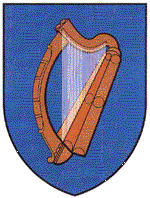NAME OF STATE
The Irish Constitution provides (Article 4) that the name of the State is Éire, or in the English language, Ireland. Normal practice is to restrict the use of the name Éire to texts in the Irish language and to use Ireland in all English language texts, with corresponding translations for texts in other languages. The Republic of Ireland Act of 1948 provides for the description of the State as the Republic of Ireland but this provision has not changed the usage Ireland as the name of the State in the English language.
The etymology of the name Éire is uncertain and various theories have been advanced. There is no doubt, however, but that it is of considerable antiquity. It first appears as (Ierne) in Greek geographical writings which may be based on sources as early as the fifth century B.C. In Ptolemy's Map (ca. l50 A.D.) the name appears as (Iouernia); some such form was transliterated into Latin as Iuverna. The standard Latin form, Hibernia, first appears in the works of Caesar, who seems to have confused it with the Latin word hibernus (wintry). Ériu, the Old Irish form of Éire, was current in the earliest Irish literature. The modern English word Ireland derives from the Irish word Éire with the addition of the Germanic word land. In Irish mythology, Eriu was one of three divine eponyms for Ireland, together with Banba and Fódla. The idea of Ireland as a heroine re-appears as a common motif in later literature in both Irish and English.
 FLAG
FLAG The national flag of Ireland is a tricolour of green, white and orange. The tricolour is rectangular in shape, the width being twice its depth. The three colours are of equal size, vertically disposed, and the green is displayed next to the staff.
The flag was first introduced by Thomas Francis Meagher during the revolutionary year of 1848 as an emblem of the Young Ireland movement, and it was often seen at meetings alongside the French tricolour
The green represents the older Gaelic and Anglo-Norman element in the population, while the orange represents the Protestant planter stock, supporters of William of Orange. The meaning of the white was well expressed by Meagher when he introduced the flag. 'The white in the centre,' he said, 'signifies a lasting truce between the 'Orange' and the 'Green' and I trust that beneath its folds the hands of the Irish Protestant and the Irish Catholic may be clasped in heroic brotherhood.'
It was not until the Rising of 1916, when it was raised above the General Post Office in Dublin, that the tricolour came to be regarded as the national flag. It rapidly gained precedence over any which had existed before it, and its use as a national flag is enshrined in the Constitution of Ireland.
 ARMS
ARMS The heraldic harp is invariably used by the government, its agencies and its representatives at home and abroad. It is engraved on the seal matrix of the of office of President as well as on the reverse of the coinage of the state. It is also emblazoned on the distinctive flag of the President of Ireland - a gold harp with silver strings on an azure field.
The model for the artistic representation of the heraldic harp is the fourteenth century harp now preserved in the Museum of Trinity College, Dublin, popularly known as the Brian Boru harp.
NATIONAL ANTHEM
The text of The Soldier's Song (Amhrán na bhFiann), consisting of three stanzas and a chorus, was written in 1907 by Peadar Kearney, who together with Patrick Heeney also composed the music. It was first published in the newspaper, Irish Freedom in 1912. The chorus was formally adopted as the National Anthem in 1926, displacing the earlier Fenian anthem, God Save Ireland. A section of the National Anthem (consisting of the first four bars followed by the last five) is also the Presidential Salute.